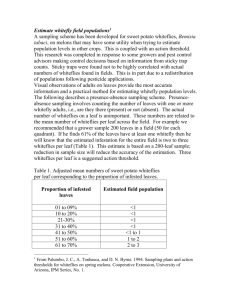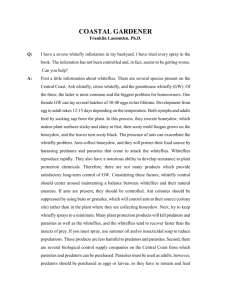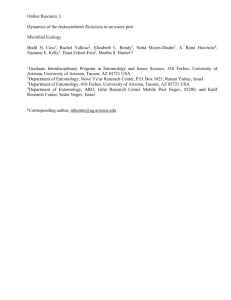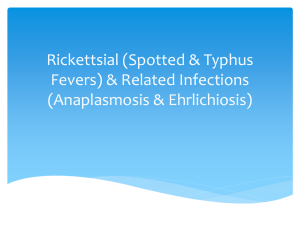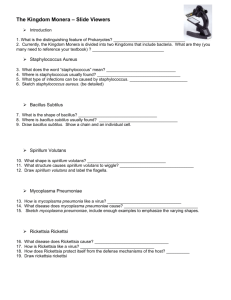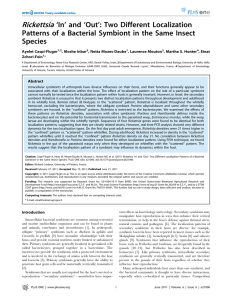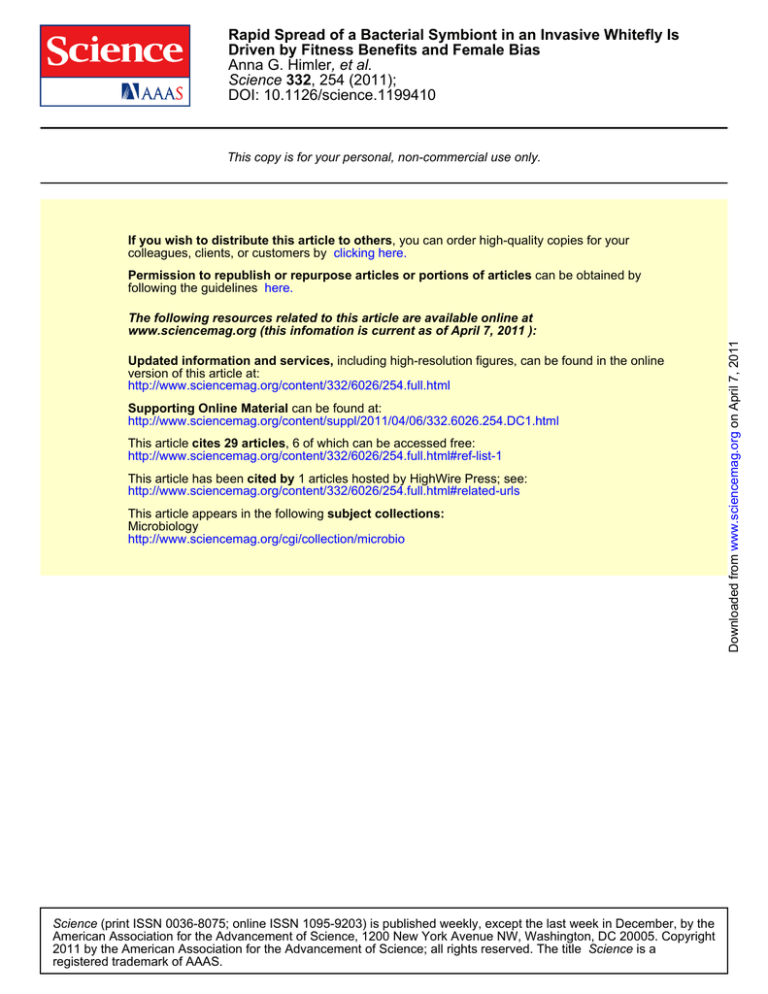
Rapid Spread of a Bacterial Symbiont in an Invasive Whitefly Is
Driven by Fitness Benefits and Female Bias
Anna G. Himler, et al.
Science 332, 254 (2011);
DOI: 10.1126/science.1199410
This copy is for your personal, non-commercial use only.
If you wish to distribute this article to others, you can order high-quality copies for your
colleagues, clients, or customers by clicking here.
Permission to republish or repurpose articles or portions of articles can be obtained by
following the guidelines here.
Updated information and services, including high-resolution figures, can be found in the online
version of this article at:
http://www.sciencemag.org/content/332/6026/254.full.html
Supporting Online Material can be found at:
http://www.sciencemag.org/content/suppl/2011/04/06/332.6026.254.DC1.html
This article cites 29 articles, 6 of which can be accessed free:
http://www.sciencemag.org/content/332/6026/254.full.html#ref-list-1
This article has been cited by 1 articles hosted by HighWire Press; see:
http://www.sciencemag.org/content/332/6026/254.full.html#related-urls
This article appears in the following subject collections:
Microbiology
http://www.sciencemag.org/cgi/collection/microbio
Science (print ISSN 0036-8075; online ISSN 1095-9203) is published weekly, except the last week in December, by the
American Association for the Advancement of Science, 1200 New York Avenue NW, Washington, DC 20005. Copyright
2011 by the American Association for the Advancement of Science; all rights reserved. The title Science is a
registered trademark of AAAS.
Downloaded from www.sciencemag.org on April 7, 2011
The following resources related to this article are available online at
www.sciencemag.org (this infomation is current as of April 7, 2011 ):
Rapid Spread of a Bacterial Symbiont
in an Invasive Whitefly Is Driven by
Fitness Benefits and Female Bias
Anna G. Himler,1,2 Tetsuya Adachi-Hagimori,2,4 Jacqueline E. Bergen,2 Amaranta Kozuch,2
Suzanne E. Kelly,2 Bruce E. Tabashnik,2 Elad Chiel,2,3 Victoria E. Duckworth,2
Timothy J. Dennehy,2,5 Einat Zchori-Fein,3 Martha S. Hunter2*
Maternally inherited bacterial symbionts of arthropods are common, yet symbiont invasions of host
populations have rarely been observed. Here, we show that Rickettsia sp. nr. bellii swept into a
population of an invasive agricultural pest, the sweet potato whitefly, Bemisia tabaci, in just 6 years.
Compared with uninfected whiteflies, Rickettsia-infected whiteflies produced more offspring, had
higher survival to adulthood, developed faster, and produced a higher proportion of daughters. The
symbiont thus functions as both mutualist and reproductive manipulator. The observed increased
performance and sex-ratio bias of infected whiteflies are sufficient to explain the spread of Rickettsia
across the southwestern United States. Symbiont invasions such as this represent a sudden
evolutionary shift for the host, with potentially large impacts on its ecology and invasiveness.
he life history traits of multicellular organisms, generally thought of as fundamental properties of the organism themselves,
are often influenced by interactions with symbiotic species (1–4). These symbiont associations
may form enduring evolutionary relationships
with their hosts but can also be dynamic, entering
and leaving populations in spans of a few years to
thousands of years (5, 6). The maternally inherited, endosymbiotic bacteria of insects comprise
some of the most intimate of these associates.
These symbionts spread in host populations either by increasing the fitness of all infected hosts
or by manipulating host reproduction in ways
that increase maternal transmission of the sym-
T
1
Center for Insect Science, The University of Arizona, Post Office
Box 210106, Tucson, AZ 85721–0106, USA. 2Department of
Entomology, The University of Arizona, Forbes 410, Tucson, AZ
85721–0036, USA. 3Entomology Lab, Newe Ya’ar Research
Center, Agricultural Research Organization, Post Office Box
1021, Ramat Yishay, 30095, Israel. 4Research Institute of Environment, Agriculture and Fisheries, Osaka Prefectural Government, 442 Shakudo, Habikino, Osaka 583-0862, Japan.
5
Global Insecticide Resistance Management, Bayer CropScience Limited Partnership, 2 T.W. Alexander Drive, Research
Triangle Park, NC 27709, USA.
*To whom correspondence should be addressed. E-mail:
mhunter@ag.arizona.edu
biont. Although the former is clearly beneficial to
the host, the female-biased sex ratios or reproductive incompatibility caused by the latter are
not in the host’s genetic interests and are considered reproductive parasitism (7). Generally symbionts fall clearly into one of these categories
and/or symbiont spread can be clearly assigned to
one or the other function [e.g., (8)]. Here we describe the rapid spread of a bacterial symbiont,
Rickettsia sp. nr. bellii, in a population of an invasive whitefly, Bemisia tabaci. Rickettsia infection increases whitefly performance; infected
whiteflies produce more offspring that survive
to adulthood at greater rates and develop more
quickly. Symbiont infection also causes a strong
female bias. Our results provide evidence of a
rapid symbiont invasion in nature driven by the
simultaneous expression of two host phenotypes,
both contributing to symbiont spread.
Intracellular bacterial symbionts are common
in insects. For example, Wolbachia is estimated to
infect 66% of all insects (9), and ~10% of insect
species have obligate nutritional symbionts that
provide essential nutrients to their insect hosts
(10). The endosymbiotic a-proteobacteria in the
genus Rickettsia are best known for causing
arthropod-vectored human diseases such as typhus
and Rocky Mountain spotted fever (11). However, recent surveys have uncovered a diversity
of Rickettsia in arthropod hosts that are not blood
feeders (12, 13). In the majority of these cases,
the role of Rickettsia is unknown [e.g., (14)], but
they may cause plant disease or manipulate arthropod host reproduction in ways that enhance
transmission. For example, different Rickettsia
species cause male-killing in a coccinellid beetle
and parthenogenesis in parasitoid wasps (12, 15).
The host of Rickettsia sp. nr. bellii in the current study is the sweet potato whitefly, B. tabaci
(Hemiptera: Aleyrodidae). This sap-feeding insect is cosmopolitan and one of the worst pests of
tropical and warm-temperate agriculture worldwide (16). B. tabaci is a species complex composed of several populations or biotypes that are
genetically distinguishable, are more or less reproductively isolated, and differ in a wide range
of biological characteristics, including invasiveness (17). These “biotypes” house distinct symbiont complements (18, 19). In addition to Portiera
aleyrodidarum, the obligate nutritional symbiont
that is thought to supplement the amino acid–
poor diet (20), populations of B. tabaci contain
different suites of facultative symbionts, including species of Wolbachia, Cardinium, Hamiltonella,
Fritschea, Arsenophonus, and Rickettsia (19). The
B biotype, the dominant B. tabaci biotype in the
United States and the subject of this study, is
fixed for both P. aleyrodidarum and Hamiltonella
defensa (18, 21). The roles of these facultative
symbionts are largely unknown but likely contribute to the biological differences observed
among whitefly biotypes (19).
Here, we report the rapid spread of Rickettsia
sp. nr. bellii (referred to as Rickettsia hereafter) in
B. tabaci in the southwestern United States. Preserved samples of whiteflies from several sites in
Arizona, New Mexico, and California show that
the frequency of infection rose from 1% in 2000
to 51% in 2003 and to 97% in 2006 (Fig. 1) (22).
Samples taken in 2008 and 2009 indicate that
infection rates continue at near fixation. Given
that B. tabaci may complete as many as 13 generations per year in the desert southwest (23), the
spread from low Rickettsia frequency to near fixation occurred in less than 80 generations. This
speed of increase is comparable to, or faster than,
known examples such as the Wolbachia invasion
Fig. 1. Spread of Rickettsia in B. tabaci. The black proportion of circles represents uninfected whiteflies, and gray represents Rickettsia-infected whiteflies. Numbers
indicate sample size. Infection rate spread from 0.01 in 2000 (N = 103), to 0.51 in 2003 (N = 47), to 0.97 in 2006 (N = 70), and to 0.94 in 2008 (N = 90).
254
8 APRIL 2011
VOL 332
SCIENCE
www.sciencemag.org
Downloaded from www.sciencemag.org on April 7, 2011
REPORTS
REPORTS
15
10
0
7
R+
60
7
8
8
40
8
20
6
8
8
8
0
P
F1
F3
F5
Fig. 2. Spread of Rickettsia infection in population
cages of whiteflies over five generations on three
host plants from 14% starting frequency. Numbers
indicate the number of replicate cages per plant
type at each generation. Control cages were inoculated only with R– whiteflies and served as a check
to detect possible contamination. A general linear
model analysis showed that frequencies of infection
changed significantly over time (P < 0.0001) and
that the host plant influenced frequencies in interaction with time (P < 0.0001).
R-
350 D
300
250
200
150
100
50
0
R+
R-
100 E
90
80
70
60
50
40
30
20
10
0
Downloaded from www.sciencemag.org on April 7, 2011
20
100 C
90
80
70
60
50
40
30
20
10
0
Percent female
25
100 B
90
80
70
60
50
40
30
20
10
0
can dramatically change whitefly performance
(24). Alternatively, Rickettsia could serve as a
nutritional mutualist or a defensive mutualist
against cryptic pathogens present in the field and
laboratory [e.g., (8, 25)].
Our results contrast with previous work from
Israel that showed slight performance benefits
(R+ whiteflies developed faster than R–) but
no reproductive manipulation associated with
Rickettsia infection in the B biotype of B. tabaci
(26). The reason for this disparity is unclear,
but whiteflies in Israel also show lower Rickettsia
infection frequencies in the field (18), suggesting
a fundamental difference between the Israeli and
U.S. whitefly-Rickettsia interactions.
The results of this study show both host reproductive manipulation (strong female bias) and
large fitness benefits associated with a single
symbiont lineage. Multiple roles have recently been
discovered for a few symbionts. A Wolbachia
strain previously shown to cause weak reproductive incompatibility in Drosophila melanogaster
(27) was shown to confer strong virus resistance
(8). More commonly, reproductive manipulator
symbionts have been associated with modest increases in performance relative to uninfected individuals, likely as a result of coevolution of
host and symbiont lineages [e.g., (28, 29)].
The sex-ratio bias and performance benefits
associated with Rickettsia infection in the current
study both provide an explanation for the sweep
of Rickettsia in the field and in the laboratory.
R+
R-
80
Percent female
30
5
5
Mean juvenile progeny
per 20 females
Percent infected
80
A
35
Percent survival to adulthood
control n = 3
melon
cowpea
cotton
40
Percent survival to adulthood
100
3C) (Wald’s c2,1 df = 9.52, P < 0.002). An experiment with cohorts of whiteflies on whole
cowpea plants produced similar results (Fig. 3, D
to F). Rickettsia-infected females produced more
juvenile progeny (Fig. 3D) (F1,6 = 53.37, P <
0.0003), had greater survival to adulthood (Fig.
3E) (Wald’s c2,1 df = 93.52, P < 0.0001), and had
more female-biased sex ratios (Fig. 3F) (c2,1 df =
9.64, P < 0.002) than uninfected females. In
addition, the latter experiment showed R+ females and males develop 1 to 2 days faster than
R– whiteflies (Fig. 4) (tfemales,14 df = 5.82, P <
0.0001; tmales,14 df = 2.37, P < 0.05).
To determine whether the benefits of infection observed in the lab were sufficient to explain the rate of spread measured in the field, we
used a simple growth model that incorporated
the effects of infection on whitefly fecundity, survival, and sex ratio, as measured in two separate
laboratory experiments (22). Using the data from
either of the two experiments, the results from the
model indicate that the observed effects of infection were sufficient to explain the rate of spread
in the field (22). The rate of spread predicted
from the model was higher than that seen in the
field, suggesting that the spread in the field was
slowed by one or more factors not included in
the model (22).
How Rickettsia influences performance and
sex ratio of whiteflies is unknown. Among possible
mechanisms are manipulation of plant quality by
the Rickettsia-infected whiteflies; plant quality
Mean adult progeny
per female
of Drosophila simulans documented in California by Turelli and Hoffmann (6).
To determine whether Rickettsia also spreads
in the laboratory, the frequencies of Rickettsia
were followed over five whitefly generations on
three host plants (cotton, melon, and cowpea). The
infection spread quickly when initiated at 14% of
hosts infected (Fig. 2) (Wald’s c2 time,2 df = 59.48,
P < 0.0001; Wald’s c2 time × host plant,4 df = 31.22,
P < 0.0001). These data show that spread can
occur on whitefly populations reared on at least
three different host plants in the laboratory and is
not limited by factors that occur only in the field,
such as a particular host plant or natural enemy.
How did Rickettsia spread? After an introgression series of crosses to homogenize genetic
background (22), we examined the rates of both
vertical and horizontal transmission of Rickettsia
in whiteflies. Experiments showed near perfect
vertical transmission of Rickettsia from infected
mothers to daughters (99.17% infected; n = 120
daughters from 18 mothers). In contrast, the rate
of horizontal transmission from infected males
to uninfected females on the same plant did not
differ significantly from 0% (median = 0% infection for 8 replicates) (22). Therefore, subsequent experiments compared the performance
of Rickettsia-infected (R+) and uninfected (R–)
whiteflies.
Rickettsia-infected whiteflies on cowpea leaf
disks produced almost double the number of adult
progeny over their lifetimes (Fig. 3A) (t,47 df =
4.55, P < 0.0001), and their offspring had greater
survival to adulthood relative to uninfected whiteflies (Fig. 3B) (Wald’s c2,1 df = 14.37, P < 0.001).
Moreover, R+ females produced a higher proportion of daughters than R– whiteflies, which
would also contribute to Rickettsia spread (Fig.
R+
R-
R+
R-
F
70
60
50
40
30
20
10
R+
R-
0
Fig. 3. (A to C) Life history parameters of R+ and R– whiteflies on cowpea leaf disks. (A) Mean adult
progeny produced per female after a 3-day oviposition period T SEM (P < 0.0001). (B) Percentage survival
to adulthood (P < 0.001). (C) Sex ratio (percentage female, P < 0.002). (D to F) Life history parameters of
R+ and R– whiteflies on whole cowpea plants. (D) Mean juvenile progeny produced per cohort of 20
females after a 5-day oviposition period T SEM (P < 0.0003). (E) Percentage survival to adulthood (P <
0.0001). (F) Sex ratio (percentage female, P < 0.002). Sample sizes were 21 to 29 individual females per
treatment for (A) to (C) and eight replicates per treatment of 20 females each for (D) to (F) (22).
www.sciencemag.org
SCIENCE
VOL 332
8 APRIL 2011
255
1
1
A
0.9
0.9
0.8
0.8
0.7
0.7
0.6
0.6
0.5
0.5
0.4
0.4
0.3
0.3
0.2
0.2
0.1
0.1
0
0
17 18 19 20 21 22 23 24 25 26 27 28 29 30 31 32 33
B
17 18 19 20 21 22 23 24 25 26 27 28 29 30 31 32 33
Day
Day
Fig. 4. Development time of R+ (black) and R– (light gray) progeny, expressed as the cumulative proportion
emerged. (A) On average, R+ females emerged 2.26 days earlier than R– females (P < 0.0001). (B) On
average, R+ males emerged 1.32 days earlier than R– males (P < 0.03).
The speed at which Rickettsia moved through the
whitefly population and the apparent differences
in the phenotype of the association in Israel and
the United States suggest an especially dynamic
interaction between Rickettsia and their whitefly
hosts.
In general, new associations of inherited
symbionts and hosts may result in rapid evolution
of both partners and phenotypic shifts that optimize the symbiosis (29). Both the transformation of a host population with a new symbiont
infection and the subsequent coevolution of the
symbiotic partners are important sources of evolutionary novelty and adaptation for insect hosts.
In hosts that are invasive agricultural pests or
disease vectors, symbiont infection may both increase the speed at which they adapt to their new
environment and exacerbate their influence (1).
Clarifying the role of symbiotic microbes may
offer insights for ameliorating pest invasiveness
or impact (30, 31).
References and Notes
1. D. M. Richardson, N. Allsopp, C. M. D'Antonio,
S. J. Milton, M. Rejmanek, Biol. Rev. Camb. Philos. Soc.
75, 65 (2000).
2. R. J. Rodriguez et al., ISME J. 2, 404 (2008).
256
3. K. M. Oliver, J. A. Russell, N. A. Moran, M. S. Hunter,
Proc. Natl. Acad. Sci. U.S.A. 100, 1803 (2003).
4. S. L. Goodacre et al., BMC Biol. 7, 32 (2009).
5. J. H. G. V. Schulenburg et al., Genetics 160, 1075
(2002).
6. M. Turelli, A. A. Hoffmann, Nature 353, 440
(1991).
7. J. Engelstadter, G. D. D. Hurst, Annu. Rev. Ecol. Evol.
Syst. 40, 127 (2009).
8. L. M. Hedges, J. C. Brownlie, S. L. O'Neill, K. N. Johnson,
Science 322, 702 (2008).
9. K. Hilgenboecker, P. Hammerstein, P. Schlattmann,
A. Telschow, J. H. Werren, FEMS Microbiol. Lett. 281,
215 (2008).
10. A. Douglas, Biol. Rev. Camb. Philos. Soc. 64, 409
(1989).
11. D. H. Walker, N. Ismail, Nat. Rev. Microbiol. 6, 375
(2008).
12. S. J. Perlman, M. S. Hunter, E. Zchori-Fein, Proc. Biol. Sci.
273, 2097 (2006).
13. L. A. Weinert, J. H. Werren, A. Aebi, G. N. Stone,
F. M. Jiggins, BMC Biol. 7, 6 (2009).
14. A. Behar, L. J. McCormick, S. J. Perlman, Appl. Environ.
Microbiol. 76, 2280 (2010).
15. M. Giorgini, U. Bernardo, M. M. Monti, A. G. Nappo,
M. Gebiola, Appl. Environ. Microbiol. 76, 2589
(2010).
16. M. R. V. Oliveira, T. J. Henneberry, P. Anderson, Crop
Prot. 20, 709 (2001).
17. A. Dinsdale, L. Cook, C. Riginos, Y. M. Buckley,
P. De Barro, Ann. Entomol. Soc. Am. 103, 196
(2010).
8 APRIL 2011
VOL 332
SCIENCE
18. E. Chiel et al., Bull. Entomol. Res. 97, 407
(2007).
19. G. Gueguen et al., Mol. Ecol. 19, 4365 (2010).
20. M. L. Thao, P. Baumann, Appl. Environ. Microbiol. 70,
3401 (2004).
21. E. Zchori-Fein, J. K. Brown, Ann. Entomol. Soc. Am. 95,
711 (2002).
22. Materials and methods are available as supporting
material on Science Online.
23. J. C. Palumbo, A. R. Horowitz, N. Prabhaker, Crop Prot.
20, 739 (2001).
24. M. Jiu et al., PLoS ONE 2, e182 (2007).
25. L. A. Moreira et al., Cell 139, 1268 (2009).
26. E. Chiel et al., Ann. Entomol. Soc. Am. 102, 413
(2009).
27. A. A. Hoffmann, D. J. Clancy, E. Merton, Genetics 136,
993 (1994).
28. S. L. Dobson, E. J. Marsland, W. Rattanadechakul,
Genetics 160, 1087 (2002).
29. A. R. Weeks, M. Turelli, W. R. Harcombe, K. T. Reynolds,
A. A. Hoffmann, PLoS Biol. 5, 997 (2007).
30. S. Aksoy, B. Weiss, G. Attardo, in Transgenesis and the
Management of Vector-Borne Disease, S. Aksoy, Ed.
(Springer, New York, 2008), vol. 627, pp. 35–48.
31. C. J. McMeniman, S. L. O'Neill, C.-C. Chen, PLoS Negl.
Trop. Dis. 4, e748 (2010).
32. We thank H. Kim, N. Doidge, N. Dowdy, and J. Garcia
for technical help and V. Corby-Harris and M. Torabi
for advice on analyses. We are grateful to K. Oliver for
helpful comments on an earlier version of the
manuscript. A.G.H. was funded by NIH training grant
1K 12 GM00708, and E.C. was funded in part by the
United States–Israel Binational Agricultural Research and
Development fellowship (GS-1-2007). This research was
supported by Binational (US-Israel) Science Foundation
grant 2004416 and U.S. Department of Agriculture
National Research Initiative Cooperative State
Research, Education, and Extension Service grant
2006-35302-17165 to M.S.H. and E.Z.-F. and
NSF grant DEB-1020460 to M.S.H. and A.G.H.
Sequences have been deposited in GenBank under
accession numbers HQ439024 to HQ439027,
HQ997365, and JF288560.
Supporting Online Material
www.sciencemag.org/cgi/content/full/332/6026/254/DC1
Materials and Methods
SOM Text
Table S1
References
22 October 2010; accepted 10 February 2011
10.1126/science.1199410
www.sciencemag.org
Downloaded from www.sciencemag.org on April 7, 2011
Cumulative proportion emerged
REPORTS

